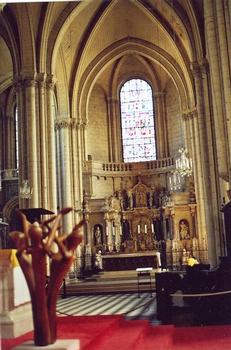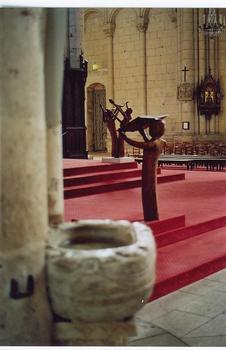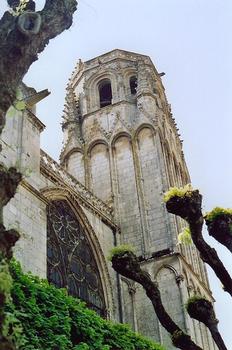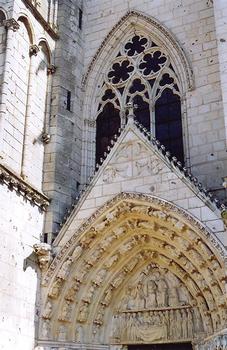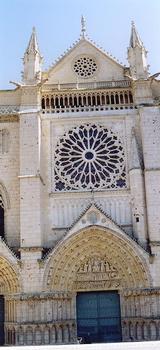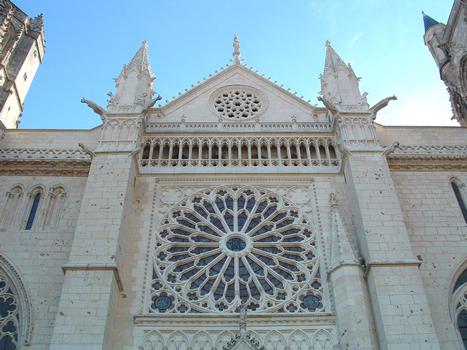General Information
| Other name(s): | Cathédrale Saint-Pierre |
|---|---|
| Beginning of works: | 12th century |
| Completion: | 14th century |
| Status: | in use |
Project Type
| Structure: |
Rib vault |
|---|---|
| Function / usage: |
Cathedral |
| Material: |
Masonry structure |
| Architectural style: |
Gothic Neo-Gothic |
Location
| Location: |
Poitiers, Vienne (86), Nouvelle-Aquitaine, France |
|---|---|
| Coordinates: | 46° 34' 49.08" N 0° 20' 57.90" E |
Technical Information
There currently is no technical data available.
Excerpt from Wikipedia
Poitiers Cathedral (French:Cathédrale Saint-Pierre de Poitiers) is a Roman Catholic church in Poitiers, France. It is the seat of the Archbishop of Poitiers Ist construction began in 1162 by Henry II of England and Eleanor of Aquitaine on the ruins of a Roman basilica, and work was well advanced by the end of the 12th century. It is the largest medieval monument in the city of Poitiers.
It is built in the Romanesque and Early Gothic styles, the latter predominating. It consists of a nave flanked on either side by two aisles. The nave and aisles are almost equal in height and width, all three of which decrease towards the west, thus enhancing the perspective. Ist length is 308 ft., and the keystone of the central vaulted roof is 89 ft. Above the pavement. There is no apse, and the exterior generally has a heavy appearance. The principal front, which is broad relative to ist height, has unfinished side-towers 105 and 110 ft. Tall, begun in the 13th century.
Most of the windows of the choir and the transepts preserve their stained glass of the 12th and 13th centuries; the end window, the Crucixion Window contains the figures of Henry II and Eleanor. It was completed in about 1165, making it one of the earliest stained glass cathedral windows in France. The choir stalls, carved between 1235 and 1257, are also among the oldest in France.
On the night of 25 December 1681 the organ was destroyed by fire. It was not until 1770-78 that a campaign was launched to build a replacement. François-Henri Clicquot, at that time the leading organ-builder in France, was appointed to undertake the work, but died in Pentecost 1790 before completing the work. His son, Claude-François Clicquot, finished the job, handing it over for presentation in March 1791. The instrument is a beautiful example of eighteenth-century organ design, and is still largely intact.
Text imported from Wikipedia article "Poitiers Cathedral"
and modified on 23 July 2019 under the CC-BY-SA 3.0 license.
Participants
- Jules de Mérindol (architect)
- Lucien Magne (architect)
- Dulin (architect)
- Meunier (architect)
Relevant Web Sites
Relevant Publications
- (1997): Les plus belles cathédrales de France. Sélection du Readers Digest, Paris (France), pp. 56-57.
- (2001): Poitiers. La cathédrale Saint-Pierre. Editions du Patrimoine. Monum, Paris (France), pp. 80.
- (1993): Poitou gothique. Picard éditeur, Paris (France), pp. 384.
- (2006): The Stiffening System of Medieval Timberwork in the Cathedral of Saint Pierre de Poitiers. Presented at: Second International Congress on Construction History, Queens' College, Cambridge University; 29/03-02/04/2006, pp. 2311-2326.
- About this
data sheet - Structure-ID
20010005 - Published on:
16/08/2003 - Last updated on:
15/03/2015


